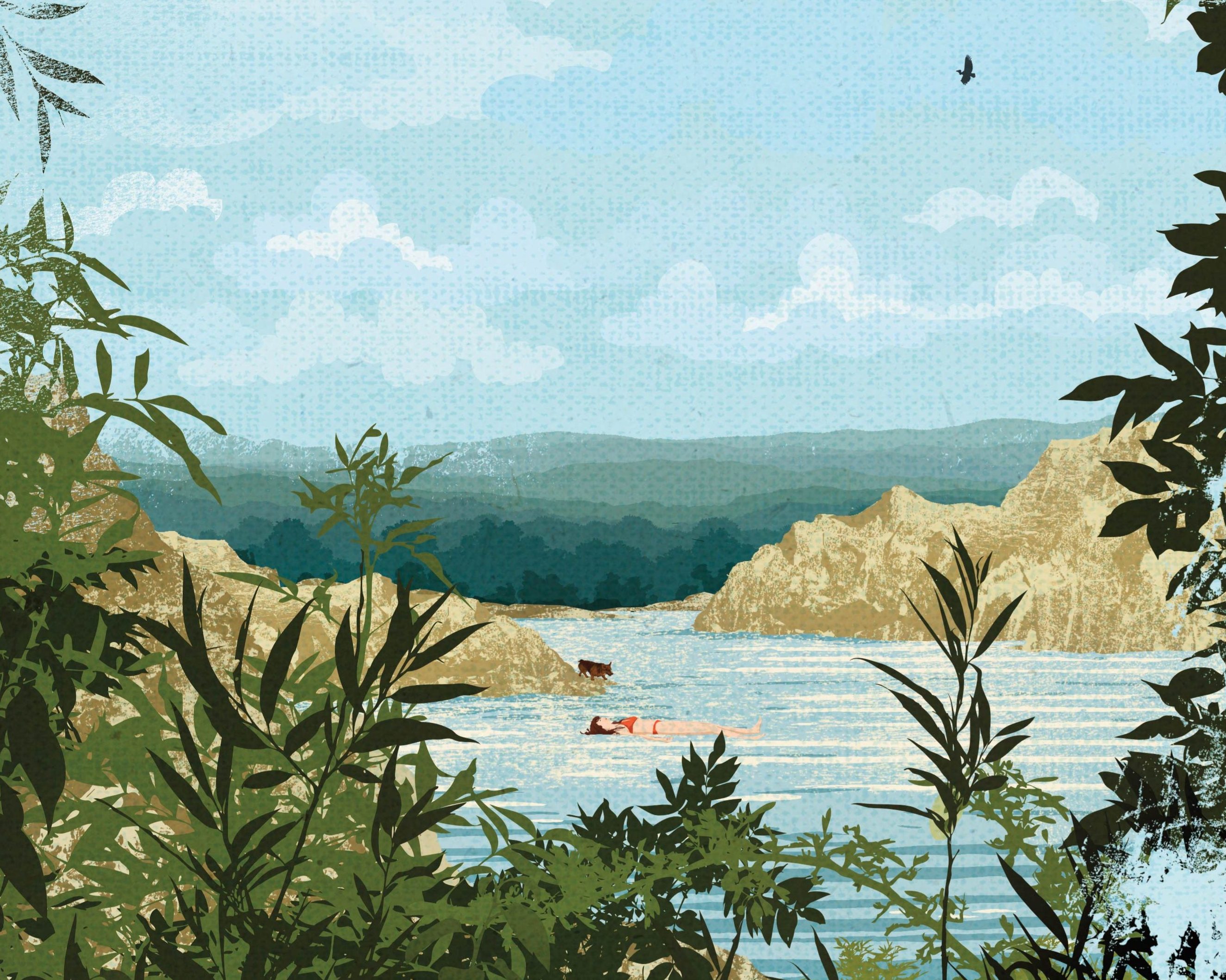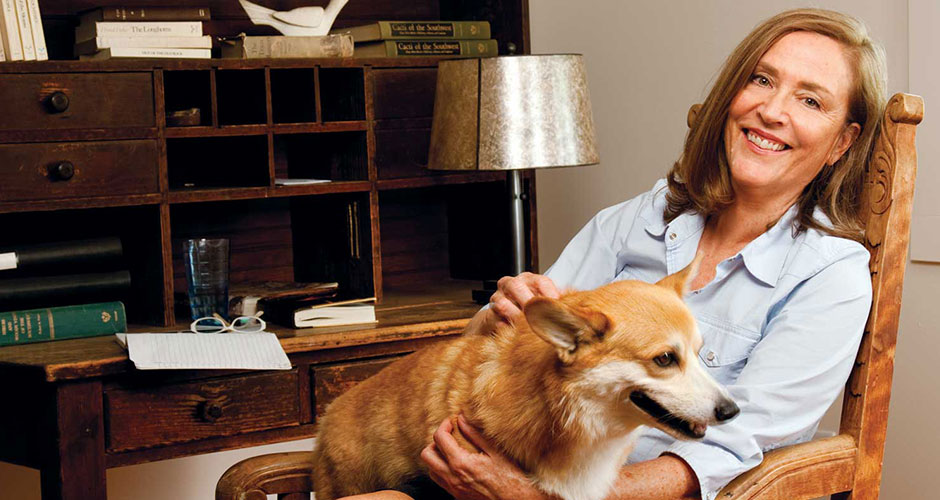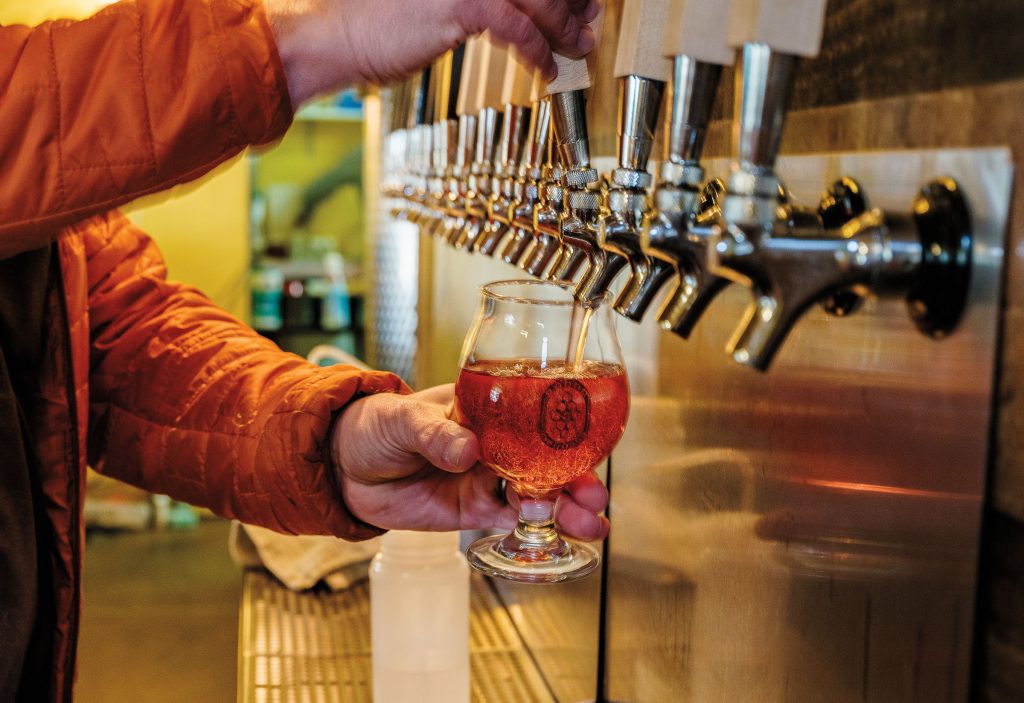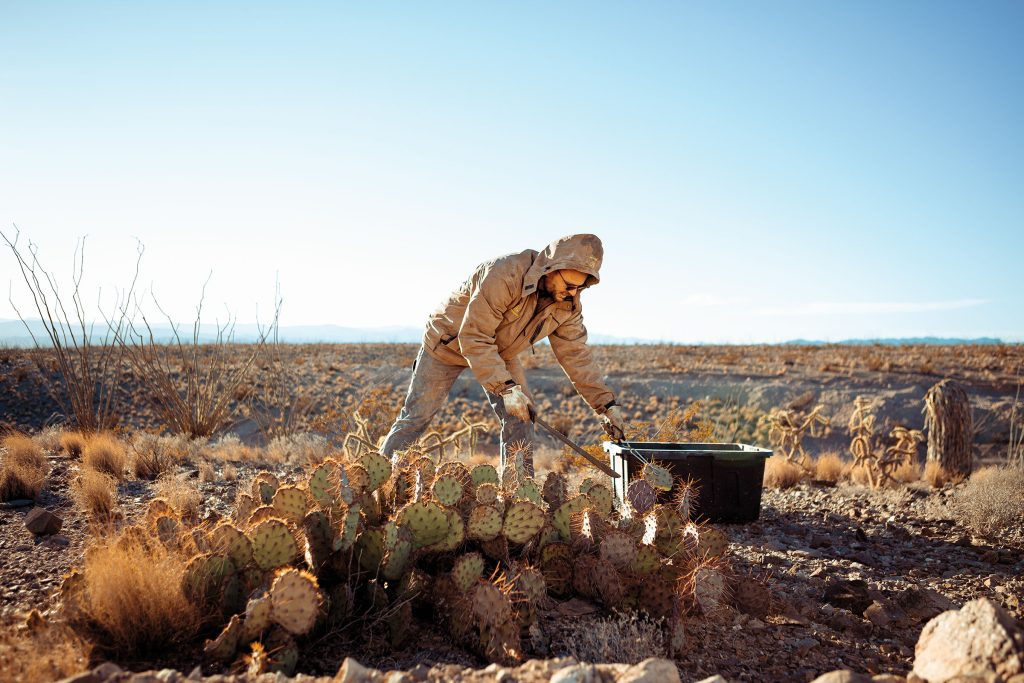
The summer solstice, when pagans once celebrated the power of light over darkness, seems the perfect time for the mystical encounter I have in mind. My husband, George Jones—not the dipsomaniacal, lawn mower-riding, no-show legend—and I set out in the most un-ranch-like vehicle imaginable, a sage-green Prius. A torrential rainstorm has swept through, leaving the sky lushly upholstered with soft gray clouds. The downpour has both dropped temperatures to unseasonable lows and raised our hopes that our favorite swimming hole will be full. We hum south on MoPac. In the backseat is our faithful dog, True. Though True would be recognized as a cow dog in his ancestral Wales, where his stumpy-legged sort had been bred to herd cattle, here in Texas he’s just a borderline foo-foo, fluffy-butted corgi. No matter, all of us are ranch veterans, car and dog included, and, now, eight years later, we are on our way to see how much Paisano we still have left in our souls.
The ranch’s guiding spirit and most famous occupant was the first great supporter of Texas letters, J. Frank Dobie. He was a folklorist, professor, columnist, author, recipient of the Medal of Freedom, celebrator of the open range, and savior of the Longhorn—a breed he immortalized in one of his most popular books, The Longhorns. Dobie and his wife/writing assistant, Bertha McKee Dobie, bought the ranch in 1959. Dobie didn’t purchase his country spread as a place to work, but rather as a retreat.
Dobie christened his “country place” Paisano, not just because it meant roadrunner in Spanish, but also for its other meaning, “compatriot.” Dobie opened Paisano to friends near and far. On long nights sweetened by the melodious calls of chuck-will’s-widows and nighthawks, Dobie and his pals would gather on the “gallery,” the long, stone porch running the length of the front of the house, and discuss life, literature, and the layers in between.
After Dobie died in 1964, his friends throughout Texas sought a way to honor their compatriot. A conversation between Bertha and two of her husband’s friends, Frank H. Wardlaw, director of the University of Texas Press; and Lon Tinkle, a book critic and professor at Southern Methodist University, spawned the idea that the best way to remember Dobie would be to purchase Paisano and use it as a writer’s retreat. Funds were raised, and the operation was turned over to UT, which facilitates the writing program.
In 1967, the university established a fellowship program designed “to stimulate creative endeavor in the arts by making it possible for a person to work without distractions.” During the early years, a few photographers and painters were granted fellowships. In 1986, two fellowships were designated: the Ralph A. Johnston Memorial Fellowship, designed for writers with some publishing and critical success, and the Jesse H. Jones Writing Fellowship for writers at the start of their careers. With all the solitude they could desire and enough funding to forget financial cares—at least for a few months—residents are only required to do that which all writers dream of having unencumbered time to do: write.
The spot has the otherworldly feel of a grotto, shaded as it is by an enormous cottonwood arching over to nearly meet the limestone bluff on the opposite bank.
The list of fellows is an illustrious one. It includes a cornerstone of Chicana literature, Sandra Cisneros (The House on Mango Street); National Book Critics Circle Award winner Ben Fountain (Billy Lynn’s Long Halftime Walk); bestselling author Stephen Harrigan (The Gates of the Alamo); National Book Foundation honoree ZZ Packer (Drinking Coffee Elsewhere); and Pulitzer finalist Philipp Meyer (The Son). Altogether the fellows have produced more than 100 books of fiction, nonfiction, and poetry, as well as numerous feature films, PBS documentaries, and prestige television series.
As George, True, and I head south on MoPac, construction slows our progress to a crawl. George and I—as is required by law of all old-time Austinites—bitch about how bad the traffic has gotten. Soon enough, though, we are zipping along nearly deserted roads that still qualify as country. We turn off at, let’s call it Branding Iron Trail so as not to zero in too precisely on the location of this writers’ sanctuary, and traffic all but disappears. The only creature we encounter for miles is a fiberglass Longhorn that gazes forlornly at us from the yard of a ranchette. The eyes of Dobie are upon us.
A few seconds later, True’s nose begins twitching, his foxy ears perk up even higher, and, whining expectantly, he paws at the window button. We are at the exact spot where, back in our ranch days, True had always signaled that tantalizing odors, more feral than fiberglass and undetectable to the suburban human nose, had invaded the car and it was time to let that wild wind blow free. We lower all the windows. True scrambles up on his stumpy corgi legs to poke his nose out the window. Panting with the sort of doggie excitement that looks like a gigantic grin, eyes slitted in bliss, he hoovers up all the delicious, uncivilized smells and howls a low-pitched, growling song of return.
The pavement ends at a 12-foot-long gate of rusted pipe with a stylized roadrunner scampering across the sign reading “Paisano.” Without a word, I slip back into the routine we’d perfected years ago and hop out of the car, grab the heavy chain and lock that are holding the gate closed, dial in the combination, sweep the gate open, and allow George to enter, before locking out the world behind us. Once parked, True, who’s not as springy as he once was, waits to be lifted out. The instant we are on private land, the three of us are simultaneously overtaken by every Texan’s God-given right to sprinkle the thirsty land. As I squat beside True, who is lifting a leg on the rusty gate post, the pagan sun of this summer solstice bursts through the clouds and cuts diamond-sharp shadows across our faces just to remind us who truly owns this state. At that moment, I could not have felt more like a cowgirl if I had been clamping a pigging string between my teeth while doping calves for screwworm.
As the road winds down for a mile and a half through the canyon along Barton Creek, the cedar and scrub oak thicken, occasionally rising into a canopy above the road we’re crawling along now, mindful of ruts and thankful that it’s not washed out. The ranch’s sentinels, several towering limestone bluffs, rise up to greet us, a spectacular background for all the greenery.
At the wheel, George puts on a burst of speed, anxious to reach what was, for us, the heart of Paisano: Barton Creek. “You think it’s running?” he asks.
“It has to be,” I answer, certain that the recent deluge will have sent the creek flowing over the low-water crossing that had kept us trapped a couple of times during our previous stay. Not that we minded. Getting “creeked-in,” being stranded, is a badge of honor among former fellows.
“It’s not flowing,” I moan when we reach the narrow passage across a disappointingly low and ominously stagnant creek. This does not bode well for our cherished swimming hole. We stop and strain for a glimpse of the pristine pool where we’d enjoyed the finest moments of every day we’d spent at Paisano. But weeds now choke the creek, blocking our view of the swimming hole. What water we can see is an unmoving brackish yellow. It appears there will be no swim.
As Cathy and her achievement as the first woman to enlist in the peacetime U.S. military went unrecognized for the decades that followed, I increasingly felt the burden of an obligation left unfulfilled.
Wilted with disappointment, we drive on to the ranch house. If we are to believe the Handbook of Texas, and I see no reason not to, the cabin made of hand-hewn cedar that still remains at the heart of the six-room ranch house was built by the property’s second owners in the 1860s. Handsomely remodeled in 2010, the Dobies’ long front porch remains intact. In his fluffy-butted way, True wiggle-waddles across the length of the gallery, pausing to shoot a glance back at me that I anthropomorphize into the question, “Do you remember?”
I do. The three of us had celebrated our first night at the ranch in 2010 with a swim followed by a cocktail on the gallery. Dive-bombing hummingbirds had already found the feeders we’d hung, and the liquid trilling of canyon wrens filled the air. As night and a sweet alcoholic buzz descended upon us, I settled in, deeply contented, only to be jerked into high alert by the loudest, most booming roar I had ever heard.
“It’s only the old lion,” George said, reminding me of the stories we’d heard about the retired giant cat that resided at the Austin Zoo on the far side of the sound-amplifying canyon.
I relaxed, but at the next roar True levitated and shot me an accusing look that demanded, “Hey, you with the prehensile grip and car keys, do something! Now!” After much futile comforting, True, trembling with each roar, bee-lined into the house and refused to emerge. He’d done what he could to save us, and if we humans were stupid enough to ignore his warning, we deserved to be a lion’s amuse-bouche.
But it’s high noon now, the ancient lion long gone to that Serengeti in the sky, and the only sounds to be heard are the peaceable gabbling of a mother turkey, out of sight in the underbrush, talking to her chicks.
“Walkie?” I ask True. Of the three of us, True had gloried most in our time at the ranch, adopting the leash-free, country-dog life and never looking back. Our daily walk to the ruins of a cabin, built by German settlers circa 1836, had been the highlight of our day. Now, though, eight years older and starting to slow down, he answers by plopping down in the deep shade beneath what I’d thought of as Bertha’s fig tree. I know better than to invite George along. Being the true Texas boy he is, his DNA is encoded to embrace the wonder of air conditioning and shun the folly of so much as a short stroll in the blistering sun.
It’s better that I go alone anyway: I’ve got a reckoning with a ghost.
Strolling to what remains of the tall log cabin takes less than half an hour. When I turn off the main road onto a heavily wooded path, first years, then decades, fall away. It’s so quiet that a blue jay’s piercing call, jeer!, startles me. A moment later, the reverie that most often overtook me on this path settles in. Once again I am transported back in time, and I imagine myself to be the bride of the German pioneer who built the cabin. And now, following her new husband along this silent stretch, she is about to behold the home that has been built for her in the middle of such vast loneliness.
Read More
A Q&A with Sarah Bird on her new book Daughter of a Daughter of a Queen »
At the cabin, I bat away a web spun by a shockingly large spider and, stepping gingerly since many of the floorboards are either rotted or missing entirely, I walk into the small main room that once contained so many lives. I touch the expertly chiseled and chinked logs and try to imagine raising a family in this confined space, so far from friends, so close to enemies. During the Civil War, Southern marauders ravaged the anti-slavery German settlers, and as late as 1869, Comanches took scalps along Barton Creek.
Imagining the fears and loneliness of a woman surrounded by deadly foes affected me strongly. This fed directly into the novel I worked on during my residence at Paisano, Above the East China Sea, the story of young women, past and present, caught up in their country’s deadliest conflicts. Still, it wasn’t that young German wife of my fancy who made the deepest impression on me. No, she only prepared me to meet again the ghost who, in 2010, had been haunting me for 30 years: Cathy Williams.
At a Juneteenth rodeo in 1979, I first heard the incredible story of Cathy Williams, the only woman to ever serve with the Buffalo Soldiers, the legendary African American regiments formed after the Civil War. At that time, I was doing research for a photo book about what I referred to affectionately as “mutant rodeos,” those magnificent hybrids of mainstream-meets-every-subculture-in-Texas. I photographed prison, police, kid’s, Mexican-American, old-timer’s, women’s, and gay rodeos. But my favorite of them all were African American rodeos.
Though this American heroine, largely unknown until recently, seized my imagination from the first moment I heard her name, I pushed the story away for a long time. As Cathy and her achievement as the first woman to enlist in the peacetime U.S. military went unrecognized for the decades that followed, I increasingly felt the burden of an obligation left unfulfilled.
I am moving away from the shaded path and tramping Paisano’s more remote stretches when that obligation to Cathy comes back to me with a vengeance. I begin to sweat hard enough to imagine how brutal it would have been for a woman, disguised in the heavy wool and metal uniform of an infantry soldier, to march across this endless state. I feel as if Cathy has not only returned, but has inhabited me.
She reminds me that she is still waiting to take her rightful place in history. Why, she asks, does the entire world know the name of Annie Oakley, who was famous for what? Shooting over her shoulder using a mirror? Cathy is not impressed and demands to know when she will be recognized.
Eight years ago, I promised Cathy I would one day tell her story. And now, as I hike back to the ranch house where George and True wait, my mind quiets. Call it a writer’s overactive imagination or schizoid affective disorder, but I feel Cathy’s presence again as surely as if she is marching beside me. I give her the news that the historical novel I’ve created from the very limited documentation available about her life and service has just been published: Daughter of a Daughter of a Queen.
Freed, I hurry back to the house. By the time I reach the low-water crossing, however, I am soaked in both sweat and a futile desire for the magical swimming hole of the past. I am about to speed up the hill when True, clearly in thrall to a genetic imperative to herd, emerges from the undergrowth to deliver a series of git-along-little-dogie faux-nips to my heels. He corrals me, the straggler, then guides me to—of all places—the swimming hole. Following his joyous yips, I crash through the snarl of greenery to find George, dipping as skinny as a good Texas boy is required to, in “our” nearly brimming swimming hole.
I plunge in. The spot has the otherworldly feel of a grotto, shaded as it is by an enormous cottonwood arching over to nearly meet the limestone bluff on the opposite bank. The cool, chest-high water is so clear that every glittering scale on a pair of smallish bream is visible as they nibble at our toes planted on the limestone bed.
Liquid Xanax, indeed, this pocket of Barton Creek still has that same narcotizing effect. Arms outstretched, I float on my back, staring up into Dobie’s boundless sky. As I think of the 99 other fellows who, inspired by Dobie’s embracing spirit, have sheltered beneath this same patch of sky, a surprising sense of kinship comes over me. High overhead, a vulture cuts its inky calligraphy into the endless blue. For a second, I swear that bird traces the name “Cathy Williams” across the sky. But, of course, I’m imagining that—liquid Xanax!—and, of course, the vulture is gone when I look again. I drift down the creek, honored to be a member of Dobie’s harmonic community of professional isolates, my obligation fulfilled at last.
Sarah Bird’s 10th novel, Daughter of a Daughter of a Queen, was published by St. Martin’s Press in September. Also, True would like the record to indicate that at no point was he scared of any lion. There was a nip in the air; that’s why he was trembling.









